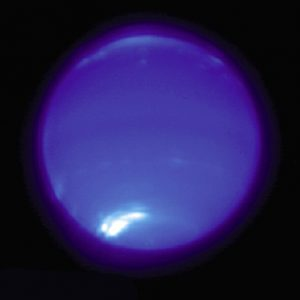Neptune’s clouds have almost disappeared, images from space and Earth confirm. The cause remains somewhat mysterious, but the timing suggests it has something to do with the strength of the current solar cycle. The announcement raises the priority of a project where NASA is calling on amateur astronomers to assist it with observations of Neptune and Uranus.
Seen in a photograph, Neptune is the easiest planet to confuse with Earth, being mostly blue with white patches. Recently, however, those patches retreated to its south pole leaving it with the lowest cover since high-quality imaging began. This might be appropriate for a planet named after the Roman god of the sea, but it leaves astronomers with some intriguing questions.
Neptune averages 4.5 billion kilometers (2.8 billion miles) from the Sun, 30 times as far as Earth, where we would expect solar influence to be weak. Consequently, UC Berkeley Professor Imke de Pater hadn’t expected to see much variation in the clouds seen over Neptune’s mid-latitudes in images taken by the Hubble Space Telescope and the W. M. Keck Observatory in Hawai’i.
Yet, starting in 2019, the clouds became rapidly less prominent. “I was surprised by how quickly clouds disappeared on Neptune,” de Pater said in a statement. Neptune’s clouds have cleared before, but not to this extent in the time we’ve been tracking them closely, which began in 1994 after Hubble’s vision was corrected.

Neptune, as imaged by the Keck II telescope just two months ago on June 21, shows clouds building near the south pole, but largely absent elsewhere.
Image Credit: Imke de Pater, Erandi Chavez, Erin Redwing (UC Berkeley)/W. M. Keck Observatory
Over that time, Neptune’s brightness peaked in 2002 thanks to extensive cloud cover, faded to a minimum in 2007, and rose again in 2015. The next minimum in 2020 was much lower than anything seen before, however. None of this seems to relate to Neptune’s long seasons.
After plotting the proportion of Neptune’s Earth-facing hemisphere covered in cloud and its overall brightness, de Pater and colleagues noticed the pattern matches that of the solar cycle, in which the Sun’s activity waxes and wanes over 11 years. Although the Sun’s output in visible and infrared light barely changes with the cycle, ultraviolet production is more varied, along with the spots, flares, and coronal mass ejections that accompany peaks.
The connection is hard to spot, because increases in UV light, specifically what is known as Lyman-alpha emissions at 121.6 nanometers, match Neptune’s cloud cover two years later, rather than immediately. If the relationship isn’t spurious, that’s an extraordinary delay to the cloud formation process.

Hubble observations of Neptune compared with the amount of ultraviolet radiation emitted by the Sun, which closely tracks the number of Sunspots.
Image Credit: NASA, ESA, LASP, Erandi Chavez (UC Berkeley), Imke de Pater (UC Berkeley)
There are signs clouds are now returning to the north polar region as the rising solar activity that has produced spectacular auroral displays recently, starts to make itself felt. This contrasts with an interpretation based on earlier data, which was that brightness was negatively correlated with solar activity.
“These remarkable data give us the strongest evidence yet that Neptune’s cloud cover correlates with the Sun’s cycle,” de Pater said. “Our findings support the theory that the sun’s UV rays, when strong enough, may be triggering a photochemical reaction that produces Neptune’s clouds.”
The delay is not the only puzzle, however. Although de Pater can see how UV would produce more clouds, she would also expect the high-energy photons to cause chemical reactions that would make these clouds darker. That doesn’t seem to be happening, and it is not clear why. There are other processes on Neptune that affect cloud cover, such as forces rising from the depths, and it’s not yet understood how everything interacts.
For all its isolation and slow orbit, Neptune has the Solar System’s fastest winds. In 1989, Voyager 2 photographed one giant storm system that was nicknamed the “Great Dark Spot” and one lesser one. We’ve since observed other dark regions but have yet to explain them.
The work has been hampered by the fact the telescopes involved have so many calls on their time they only checked in on Neptune occasionally. This is why professional astronomers are asking amateurs with large backyard telescopes to assist this September.
The findings are published in Icarus.
Source Link: Neptune’s Clouds Have Disappeared For The First Time In Almost 30 Years